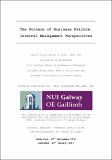| dc.description.abstract | The principal aim of this research is to gain an in-depth understanding into the process of small business failure from an internal management perspective through the exploration of multiple entrepreneurs' individual business failure experiences and consequential career choices. One of the first researchers to examine the dynamic nature of failure was Argenti (1976) with seminal research that consolidated both the notion of 'failure as a process' and 'failure as an outcome with distinctive, identifiable patterns', however whilst Argenti acknowledged the impact of bad management on business failure a clear demarcation of management errors specific to each failure path was not clear thus the nuances of the varying failure trajectories which the study devised are not apparent (Ooghe and De Prijcker, 2008). It is these nuances and similarities that this study aims to refine. The core research focus is, 'How does the process of decline evolve within a firm and what is the causal effect on management actions?' A major issue raised by Mellahi and Wilkinson (2004, p.31), the fact that 'virtually all such studies are limited to one society, the US' shall also be addressed.
The context of this study is the Producing Services Sector, a major subsector of the Irish Information and Communication Technology (ICT) industry. Small firms that closed within five years of start-up are the subject of the research. A subset of the ICT industry was chosen due to its importance to the Irish economy and the fact that the sector was subject to many interesting changes throughout the late 90's and early 00's with many segments being subjected to rapid growth, disruptive innovation, deregulation and privatisation all of which in turn led to escalated competition and substantial market investment. A qualitative research design was used and a data-set and corresponding secondary data was derived by running queries on the FAME (Financial Analysis Made Easy) database. Ultimately thirty interviewees from the dataset of two hundred and three agreed to partake in semi-structured interviews and the results were analysed using N-Vivo software.
The study's findings contributed to the extant literature in three ways. Firstly, many process studies to date have been conceptual constructs (Miller, 1977; Sharma and Mahajan, 1980; Hambrick and D'Aveni, 1988; Richardson et al., 1994; Mellahi, 2005). This study addresses this deficiency of empirically grounded studies in the literature, as it engages entrepreneurs that directly experienced failure rather than merely employing a dataset of secondary information and attempting to apply structure to it as previous studies have done (Weitzel and Jonsson, 1989, Moulton et al., 1996). A second contribution emerges from the insights into the personal and professional affects of failure on entrepreneurs' lives. The less tangible affects such as learning and stigmatisation are explored. Also the fact that this study explores the entrepreneurs' progression right through to the period following business failure presents a rich picture of the impacts the failure experience had on their lives and future activities. Thirdly this research provides an increased understanding of a long running debate in the literature, the internal and external causes of business failure. The deterministic and voluntaristic perspectives have long debated whether it is internal or external factors that have a greater amount of influence over the health of corporations. Academics tend to favour one school of thought over the other depending on their discipline, the result of which is a chasm between the two schools of thought as they evolve independently (Mellahi and Wilkinson, 2004). This research has taken both perspectives onboard and as such contributes to reducing the theoretical gaps in the literature as highlighted by Mellahi and Wilkinson (2004).
In addition to addressing the core research focus the study also outlines implications for entrepreneurs and support agencies. Finally, a 'Business Failure Process Model' was developed which offers in-depth details into the nature of failure (actions, strategies, outcomes). Furthermore the evolution of the decline process is charted by segmenting entrepreneurs on the basis of their individual experience into a four strand process model - 'Opportunist'; 'Pragmatist'; 'Experimentalist'; and 'Purist'. | en_US |


